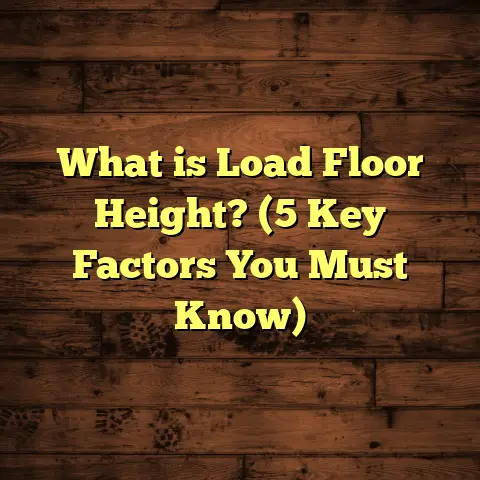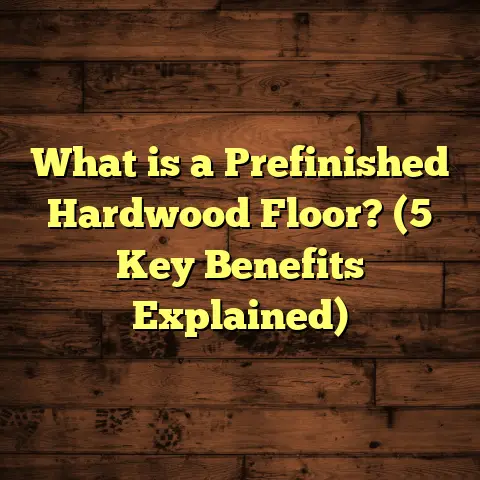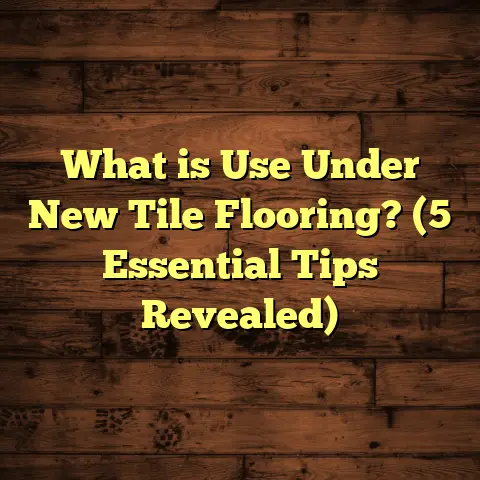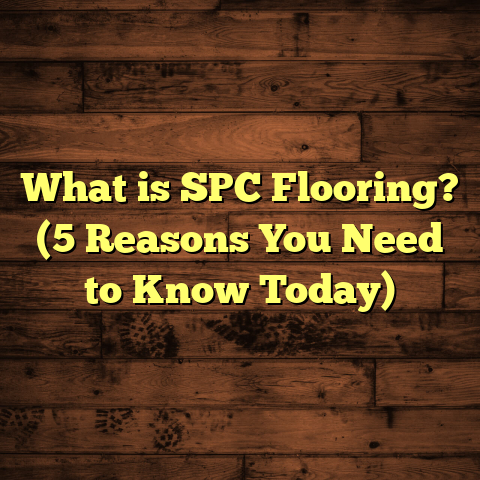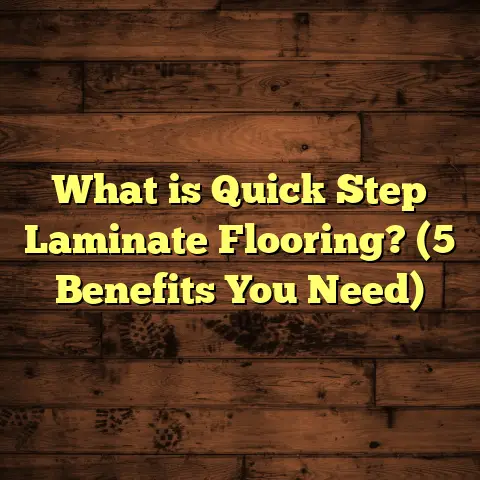What is Bamboo Floor? (5 Reasons It’s Eco-Friendly Flooring)
Imagine you’re in your living room, dreaming about a new floor that not only looks stunning but also makes you feel good about your impact on the planet. Maybe you’ve heard about bamboo flooring but aren’t quite sure what it is or why so many people rave about it being eco-friendly. You want to make a smart choice, but the options can be overwhelming.
I totally get it because I’ve been there myself—working as a flooring contractor for years, installing everything from hardwood and laminate to tile and carpet. Bamboo flooring caught my attention early on, and since then, I’ve learned a lot about what makes it unique. I’ve even watched homes transform with its warm tones and durable finish. Let me walk you through what bamboo flooring really is, why I believe it’s one of the greenest flooring choices out there, and share stories and data from my experience along the way.
What Is Bamboo Flooring? Understanding the Basics
First off, let’s break down exactly what bamboo flooring is. You might think it’s just another type of hardwood floor, but it’s actually quite different.
Bamboo is a type of grass. Yes, grass—not wood. Unlike trees that take decades to mature, some bamboo species can grow up to 3 feet every single day under the right conditions. That means bamboo can be harvested much more often without destroying the plant. Once cut, the stalk regrows quickly from its root system.
The flooring itself comes from those bamboo stalks. Here’s how it typically goes:
- The stalks are harvested when mature (usually around 3-5 years old).
- They are cut into strips.
- These strips are then dried and treated.
- Depending on the type of bamboo flooring, the strips are either laid horizontally or vertically and glued together under pressure.
- For strand-woven bamboo, the fibers are shredded before being compressed with resin to create a very dense plank.
- Finally, the planks are sanded, stained if desired, and sealed with a protective finish.
This process makes bamboo floors look similar to hardwood but with unique grain patterns and textures.
Types of Bamboo Flooring
You’ll mainly find three types:
1. Horizontal Bamboo: The strips are laid flat, showing the natural grain pattern with nodes (the “knuckles” along bamboo stalks). It has a more traditional look but can be softer.
2. Vertical Bamboo: The strips stand on edge and are glued side by side. This creates a linear grain pattern that some find more modern.
3. Strand-Woven Bamboo: This is made by shredding bamboo fibers and compressing them with adhesives under extreme pressure. It’s extremely dense and tough—much harder than most hardwoods.
Of all these, strand-woven is my favorite to install in high-traffic homes because it can handle wear and tear better than the others.
Why Bamboo Flooring Is Eco-Friendly: 5 Reasons I Trust It
I hear a lot of buzz about “green” flooring options—what actually makes them eco-friendly? For me, bamboo ticks several important boxes that others don’t always hit.
1. Fast Growth Means It’s Highly Renewable
Trees can take decades—sometimes 50 years or more—to mature enough for harvesting lumber. Bamboo finishes its growth cycle in just 3 to 5 years. Some species even grow faster in tropical climates.
Because it regrows so quickly from its root system without needing replanting, harvesting bamboo doesn’t destroy entire forests like logging does.
Years ago, I worked with a client who was passionate about sustainability but needed a durable floor for their kids’ active lifestyle. They were worried about cutting down trees for hardwood floors but loved how fast bamboo grows. Choosing bamboo gave them peace of mind that their floor wasn’t contributing to deforestation.
According to scientific studies, bamboo forests can sequester carbon dioxide at rates up to 12 tons per hectare annually—far surpassing typical tree forests that sequester between 1 to 3 tons per hectare each year. This means bamboo helps combat climate change while growing rapidly.
2. Efficient Use of Material Reduces Waste
In traditional hardwood milling, a large portion of the tree is unusable due to imperfections or shape. This leads to waste that often ends up in landfills or as low-value byproducts.
With bamboo, manufacturers use nearly every part of the stalk. The outer layer strips become flooring planks; inner fibers are shredded for strand-woven products or used in other building materials.
When I visited a bamboo flooring factory in Asia, I was impressed by their “zero waste” philosophy. Leftover scraps were repurposed into furniture components or compressed into panels for underlayment.
Industry data shows that about 90% of harvested bamboo stalks are converted into finished products compared to around 50-60% for hardwood logs. This efficiency reduces environmental impact by making full use of resources.
3. Grown Without Harmful Chemicals
Many hardwood trees require pesticides and chemical fertilizers during their growth cycle because they’re vulnerable to pests and diseases.
Bamboo, however, is naturally pest-resistant and grows robustly without needing chemical treatments. This reduces pollution from agrochemicals that can contaminate soil and water supplies.
I spoke with several bamboo farmers who emphasized that their crops thrive using organic methods alone. This aligns well with environmentally conscious building practices.
A study published in the Journal of Cleaner Production quantified this advantage: bamboo cultivation results in significantly lower environmental impact scores compared to timber farming due to minimal agrochemical use.
4. Durability Means You Replace Floors Less Often
An eco-friendly floor isn’t just about how it’s made; it’s also about how long it lasts before needing replacement.
Strand-woven bamboo scores around 6,000 on the Janka hardness scale—that’s roughly four times harder than traditional oak or maple hardwoods (which range from 1,200 to 1,400). This means it resists dents, scratches, and wear better than many conventional woods.
I’ve installed strand-woven bamboo in busy homes—kids running around, pets scratching—and even after seven years, those floors look fantastic with minimal refinishing required. That kind of longevity means fewer resources used over time repairing or replacing floors.
5. Biodegradable at End of Life
When floors reach their end of life—whether decades later or due to remodeling—what happens to them matters environmentally.
Unlike vinyl or laminate floors which contain plastics and toxic chemicals harmful in landfills, bamboo is biodegradable. It breaks down naturally without releasing harmful substances into soil or groundwater.
Some manufacturers even offer recycling programs where old bamboo flooring is processed into mulch or other sustainable products.
I once helped a client remove their decade-old bamboo floor and arranged for the scraps to be composted rather than discarded in landfill waste sites. It was satisfying knowing this material could return safely to nature.
What I’ve Learned Installing Bamboo Floors: Tips From the Field
After years installing bamboo floors in various types of homes—from cozy apartments to large family houses—I’ve noticed some important things you should know if you’re considering this flooring option:
Moisture Sensitivity Means Proper Preparation Is Key
Bamboo is more sensitive to moisture changes than some hardwoods because it’s a grass with natural fibers that expand and contract based on humidity levels.
When installing bamboo floors, acclimating the planks in your home for at least 48-72 hours before installation helps them adjust to your local climate conditions.
Also, using moisture barriers beneath the flooring and ensuring proper subfloor preparation helps prevent warping or buckling later on.
I recently helped a homeowner in a humid coastal area who skipped this step—their floor developed slight gaps shortly after installation. After fixing moisture issues and adding barriers, their floor stabilized perfectly.
Watch Out for Low-Quality Adhesives
Some lower-end bamboo flooring uses adhesives containing formaldehyde or other volatile organic compounds (VOCs) that can off-gas harmful chemicals indoors.
I always recommend choosing products labeled as no added formaldehyde (NAF) or low-VOC certified by organizations like FloorScore or GREENGUARD.
Good ventilation after installation also helps reduce any initial odors.
Budget Wisely for Quality
Bamboo flooring prices vary widely depending on type and finish:
- Horizontal or vertical bamboo usually costs around $3-$6 per square foot.
- Strand-woven options tend to be $5-$8 per square foot because of their durability.
- High-end custom stains or finishes push prices higher but can be worth it for longevity and appearance.
Cheaper products may save money upfront but might lack durability or eco-certifications I value highly.
My Personal Experience With Bamboo Flooring Projects
I want to share two stories that highlight why I often suggest bamboo floors:
Story #1: A Growing Family’s Durable Choice
A family with three young kids wanted a floor that could handle spills, toys dropped on it daily, and lots of foot traffic.
They loved hardwood but worried about scratches and cost over time.
I suggested strand-woven bamboo because it’s super hard and more affordable over time given its longevity.
Seven years later they called me back—they still love their floor! Minimal scratches, easy cleaning, and they appreciated supporting an eco-friendly material.
Story #2: A Designer’s Sustainable Dream
I worked with an interior designer who was passionate about sustainability. She wanted her client’s home to feature natural materials with low environmental impact.
We chose vertically laminated bamboo floors stained a rich walnut shade for warmth.
The client loved the unique grain pattern and felt good knowing their floors came from sustainably harvested materials grown organically without pesticides.
Bamboo Flooring Compared With Other Options: What The Numbers Say
Here’s a quick comparison chart showing key stats between common flooring types:
| Flooring Type | Growth Time (Years) | Durability (Janka Rating) | Avg Cost / Sq Ft | Carbon Sequestration (tons/ha/yr) | Environmental Notes |
|---|---|---|---|---|---|
| Oak Hardwood | 20 – 50 | 1,200 – 1,400 | $5 – $10 | 1 – 3 | Slow growth; moderate waste |
| Maple Hardwood | 30 – 40 | 1,200 – 1,450 | $4 – $9 | 1 – 3 | Similar issues as oak |
| Strand-woven Bamboo | 3 – 5 | ~6,000 | $4 – $8 | Up to 12 | Fast growth; low waste; biodegradable |
| Laminate | N/A | Varies (lower) | $2 – $5 | N/A | Synthetic materials; not biodegradable |
| Vinyl | N/A | Varies (lower) | $2 – $7 | N/A | Plastic-based; disposal concerns |
What Does This Mean?
If you want fast renewable material that lasts long and supports carbon capture efforts—bamboo checks all those boxes better than oak or maple hardwoods. Plus, its manufacturing wastes less material overall.
Caring For Your Bamboo Floor: Simple Tips From Me
Taking care of bamboo floors isn’t too different from hardwood but here are some pointers from my experience:
- Use soft-bristle brooms or vacuums designed for hard floors to avoid scratching.
- Clean spills immediately to prevent moisture damage.
- Avoid harsh cleaners; instead use mild soap solutions or specially formulated wood cleaners.
- Place furniture pads under legs to prevent dents.
- Refinish every few years if needed—strand-woven bamboo sands nicely.
- Control indoor humidity levels if possible (ideally between 40-60%) to reduce expansion/contraction issues.
Following these tips helps your floor stay beautiful for decades.
What About Indoor Air Quality?
You might wonder about indoor air quality since some floors release VOCs after installation.
Choosing bamboo floor products certified low-VOC by FloorScore or GREENGUARD ensures minimal off-gassing indoors—good news for allergy sufferers or families with kids.
Good ventilation during and after installation also helps clear any lingering odors quickly.
Case Study: Bamboo Floors in Green Building Projects
Several green building certifications like LEED recognize rapidly renewable materials like bamboo favorably because they reduce environmental impact over traditional timber products.
One project I was involved in—a community center aiming for LEED Gold certification—used strand-woven bamboo flooring throughout its high-use areas. The decision helped contribute points toward sustainability goals while providing long-lasting durability for heavy foot traffic events.
The center staff praised not only the look but also how easy the floors were to maintain over time without heavy refinishing costs expected from some hardwoods.
Final Thoughts From Me
Choosing flooring isn’t just about looks or cost—it’s about how your choice fits your lifestyle and values over time. Bamboo flooring offers a unique balance of beauty, strength, affordability, and eco-friendliness that few other options match.
I hope my stories, data points, and firsthand knowledge help you feel confident if you decide to go with bamboo floors for your next project. Whether you want something rugged for a busy family home or a sustainable statement piece for your design-conscious clients or yourself—I truly believe this material deserves serious consideration.
Got questions about installation? Curious how it compares in your specific climate? Need tips on care? Just ask—I’m here to help you make smart choices that look great while being kind to the planet too!
